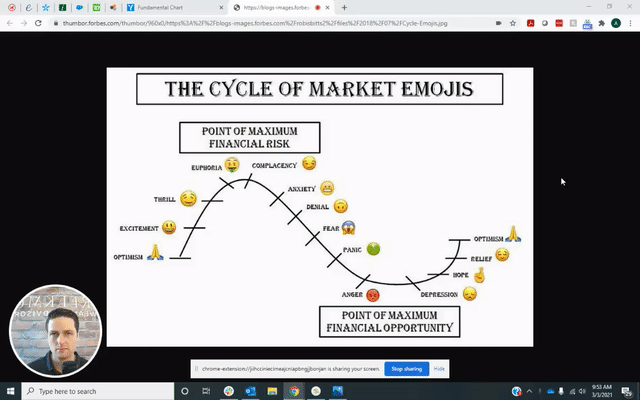
This week we're discussing the Impact of Emotions on investors. We have found that it's critical to know yourself and how you react to market swings. And to have a process in place to help you manage emotions. This chart - the cycles of Market Emotions – shows how people often react to movement in the market. As investment managers we have experienced some of these personally, and have worked with many clients over the years who have gone through all of these.
As the chart illustrates, when bull markets start we see great optimism about the future. As our investments grow and the market is moving up we have excitement and experience the thrill of making money. Then we start peaking with feelings of euphoria which lead into complacency – where we think, “Everything is going great! I’m just going to keep on making money!” Ultimately complacency leads us to become less vigilant about monitoring our investments. Then as the market moves downward, we experience anxiety and even denial as our investments lose value. This cycle can eventually give way to feelings of fear, panic, anger, and even depression.
What so often happens during this cycle, is that we see individuals allowing their emotions to dictate their actions. A recent study has found that over the last 20 years the S&P 500 has returned around 9% on average. Whereas the average investor has earned about 4 ½ % a year. (Depending upon when you look at these stats the info may be slightly different) What typically holds true is that the average investor earns about 50% less than the market as a whole. Emotions are a large factor impacting the choices investors make causing this lag in earnings.
Emotions in general are ok. It is certainly important that you recognize your emotions. However, you don’t want to be making emotional decisions as an investor.
For each of us it's important to learn from the past and to be sure that we have a process in place to deal with our emotions about investing in the future. There is much we can learn about this from our experiences this past year. We came into the end of February 2020 with the markets chugging along pretty well. Then we had the Covid-19 virus and the related economic shutdowns. This led to a sharp decrease in the S&P 500. At the bottom of the market which occurred on March 23, 2020, the S&P was down just over 30%.1
Those who were able to ride out this down cycle and stay invested in the market through this would be up about 22%. Unfortunately, what we see happen in many cases is that people feel anxiety and fear and decide to sell their investments half-way or all the way at the market bottom. The pain and fear of loss becomes too great and begins to affect people’s decision-making process.
When the market begins to recover, they begin to scramble to reinvest when the market is on the way up. So rather than selling high and buying low, people end up selling low or lower and buying high or higher. As investors that is where that “50% less return” can creep into your portfolio. It’s times like these where it's important to trust your process.
Even though we have a process, we are not going to be able to nail it every time, but last year was very illustrative of how our process worked. Shown here is our moderate aggressive model represented by the orange line. What you can see here is that we stuck to our process. We managed this model for our clients using the process that we have developed over the last 20 years. And the results speak for themselves. At the bottom of the market on March 23, when the S&P was down about 30%, our model was down about 19%. Today, if you stayed invested with us your portfolio would be up around 57%. Whereas the S&P is up about 22%. Now a lot has to go right to make results like this happen.
It is most important to recognize, is that having an investment process, trusting the process, and executing the process leads to long-term results as an investor.
Ultimately the reason we want to maximize our results based upon our risk as investors is so that we can achieve the financial goals that we have in the shortest period of time possible. At the end of the day, this is what we do for our clients. We’re here to help you avoid making those emotional decisions by using logic and reason – trusting the process to develop the returns that you need.
We would encourage you to take some time to evaluate how you have responded emotionally in the past whenever markets start to go a little crazy. If you recognize that you often give in to emotions, it might be because you are too aggressively invested in your investment accounts. Or if you are someone who does not get too emotional. You don’t look at your investment statements and get concerned. You held firm through the down and upswing, but now you have some gains in your accounts, it might be time to consider reducing some risk as we now approach a new period in our economy.
Once you’ve evaluated your emotional responses to investing, give us a call. Or talk to your trusted advisor. Let’s walk through the options for where you are today.
Sources



